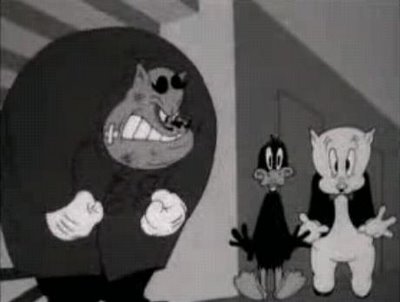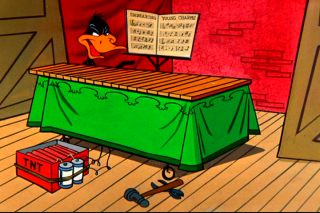Those
of us who grew up with Warner Brothers’ cartoons will proudly admit that our
store of musical knowledge increased with our enjoyment and we didn’t even know
it at the time. This prompted me to do some research and compile a spreadsheet
of music used in various cartoons.
It
became obvious that certain songs appeared in more than two features and this
gave me the basis for a “top ten” of frequently used melodies.
10. At three
iterations is “Jeepers Creepers” by Harry Warren and Johnny Mercer (1938). It
was the title of a Bob Clampett cartoon in 1939 with the hapless Porky Pig as a
cop who has to investigate “strange sounds” coming from a haunted house. The
loony ghost inside sings the song with his own appropriate lyrics before
driving Porky crazy. Then in 1941, Friz Freleng had an alley cat sing it to
Porky as a part of his nightly repertoire in Notes to You. Most
famously, though, in 1957 it provides Daffy Duck with a fast-paced tap dance
in Show Biz Bugs, also directed by Freleng. Unfortunately poor
Daffy only hears crickets from the audience for his efforts.
9. Also at three
times is “On Moonlight Bay” by Percy Wenrich and Edward Madden (1912). Freleng’s Porky’s
Duck Hunt used it first in 1937 as Porky and his dog unsuccessfully
try to capture Daffy. Then in 1942, it arises again in Chuck Jones’ My
Favorite Duck again with Porky and Daffy. And in 1948, it is a part of
Sylvester the Cat’s repertoire in Back
Alley Oproar, the remake of Notes to You, once again directed
by Freleng. Porky is now kept awake by a different cat.
8. Again at three
appearances is the “Sextet” from the opera Lucia di Lammermoor by
Donizetti (1835). Freleng used it first in 1941 as six of the nine lives of the
alley cat in Notes to You sing it as
a finale. Then it comes up twice in 1948, in Friz’s remake, Back Alley
Oproar, and in Jones’ Long Haired Hare. In the latter, Bugs
Bunny is a major distraction to a practicing opera singer. It is also one of
two cartoons where we hear, “Of course you know, this means war!”
7. “The Merry-Go-Round Broke Down,” by
Cliff Friend and Dave Franklin (1937), with two cartoons and a full-length film
to its credit. In 1938, we hear it sung by Daffy Duck in Daffy Duck and
Egghead. Egghead would later evolve into Elmer Fudd. Then Robert McKimson used
it in 1950 for Boobs in the Woods, where Porky and Daffy are once
again paired. And in 1988, Rob Hoskins sings it in Who Framed Roger
Rabbit to foil the weasels into laughing themselves to death.
6. “I’m Just Wild
About Harry,” by Eubie Blake and Noble Sissle (1921), which also had three
cartoons. Three different directors chose this song. Freleng was first in 1943
with Yankee Doodle Daffy, where Daffy puts on an entire show to
promote his nephew Sleepy Lagoon to a more than reluctant Porky Pig. Then in
1948, Daffy Duck comes home drunk to Porky with an invisible kangaroo named
Hymie and sings it substituting Hymie’s name in Robert McKimson’s Daffy
Duck Slept Here. Most recently, Michigan J. Frog sings it in 1955 in One
Froggy Evening, directed by Jones.
5. Franz Liszt’s “Hungarian
Rhapsody # 2” (1847) takes the number five slot, having been featured four
times. The first is in 1941 in Rhapsody in Rivets, where Freleng
has a construction crew playing the piece while building a skyscraper. Then,
Friz does it again in 1946 with Rhapsody Rabbit. Bugs Bunny is a
concert pianist trying to play it while being interrupted by a mouse in the
piano. Friz gives the song to Sylvester in 1948’s Back Alley Oproar and
in 2012, we see Daffy Duck sing his own lyrics in 3D while Elmer tries to shoot
him in his first one-duck show.
4. Raymond Scott’s
“Powerhouse” (1937). The dual jazz melodies of this masterwork have become
second nature to anyone familiar with the rat-race/assembly-line experience. It
appears twice in 1943. Frank Tashlin uses it in Porky Pig’s Feat while
Porky and Daffy desperately try to escape a hotel without paying. Then Clampett
featured it in Falling Hare while Bugs Bunny grapples with a
Gremlin who is gradually destroying the plane he’s flying. Next, Clampett used
it for the assembly line aspect where the babies are physically riding on one
in his 1946 Baby Bottleneck. Jones is last to play “Powerhouse”
in Duck Dodgers in the 24 ½ Century (1953) as Daffy passes
under a huge eye on his way to his director.
3. With four
playings, the third spot belongs to “You Must Have Been a Beautiful Baby” by Warren
and Mercer (1938). Jones makes it a backdrop to his 1939 Daffy Duck and
the Dinosaur while a Jack Benny-like cave man hunts Daffy with his
goofy Brontosaur (Apatosaurus now) “dog.” Then in 1940, Freleng has Elmer Fudd
play John Alden delivering a singing telegram to an Edna Mae Oliver as
Priscilla in The Hardship of Miles Standish. Then Robert McKimson
gets on the bandwagon in 1952’s Muscle Tussle where Daffy Duck
must win back his girlfriend from a muscular Southern duck. One Froggy
Evening has Michigan J. Frog sing the song in 1955 under the direction
of Jones.
2. “Largo al
Factorum” by Rossini and Cesare Sterbini (1782), the familiar “Figaro” aria at
five iterations. The same alley cat in Notes to You counts it
as a part of his performance as does Sylvester in Back Alley
Oproar (1948). Then again in 1948, Jones includes it in Long
Haired Hare. It also appears in Jones’ 1950 cartoon Rabbit of
Seville, with new lyrics supplied by Bugs and Elmer Fudd, and then Michigan
J. Frog sings it in One Froggy Evening, also for Jones.
1. The undeniable
number one is “Those Endearing Young Charms,” a 19th century
Irish folksong with words by Thomas Moore, again with five airings. Every time
this piece is played, someone is blown up. In 1944, Clampett blows up Private
Snafu in the U.S. Army’s training cartoon, Booby Traps. Then when
Yosemite Sam vows if elected to eliminate rabbits, Bugs Bunny runs against him
in Ballot Box Bunny (1951), directed by Freleng. Sam gets
blown up. Then Friz has Daffy Duck blown up in Show Biz Bugs (1957)
at a xylophone he rigged for Bugs. McKimson was not to be outdone when Wile E.
Coyote is blown up at a piano rigged for the Roadrunner in Rushing
Roulette (1965). And lastly, in 1993 as a part of the Animaniacs TV show, Slappy Squirrel
blows up Doug the Dog as she plays the xylophone intended for her in Slappy
Goes Walnuts (1993). Jon McClenahan and Chris Brandt were co-directors
of this cartoon.
Of
course, this is still a work in progress and these 10 pieces of music are only
ones I have counted so far. I probably missed some. But there is one song that
beats them all because it was sung in every cartoon my favorite Warner Brothers
character starred in. That character is none other than Foghorn Leghorn, and
the song is Stephen Foster’s “Camptown Races” (1850) – Do Dah, Do Dah.




.jpg)

No comments:
Post a Comment